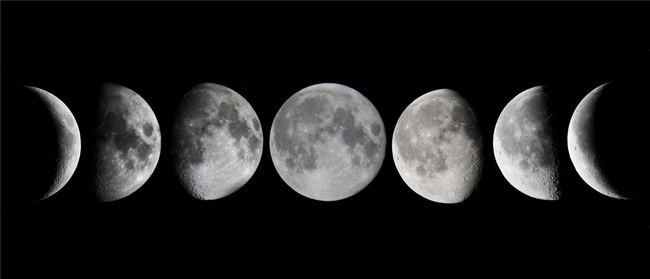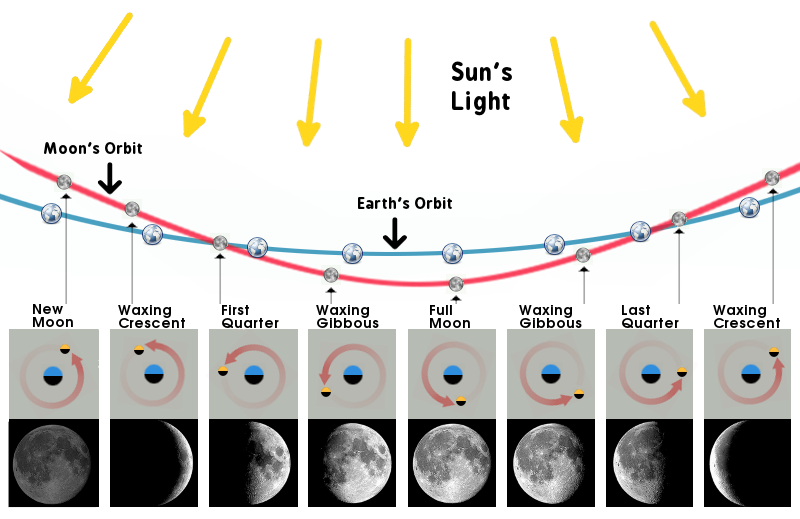Lunar Observation Project - Simplified Remix
Lunar Observation Project

The Lunar Observation Project is the cornerstone project of this astronomy unit. The objectives of this project are for you to become familiar with the phase cycle of the Moon, and its varying positions in the sky. Before you can begin, you need to know when the Moon will be visible (if it has not yet risen, you will not be able to see it no matter how hard you try!). A very good source for this information is http://www.sunrisesunset.com. From this website, you can specify your viewing location and month(s) for observing.
The lunar observation project is worth a total possible 100 points and is comprised of THREE distinct parts. You must submit each part to receive full credit. Whenever you use outside information, you must cite your source (just as you would in an English or Humanities course). The only difference with this project is that all you have to do is list the URLs of any websites that you use.

The phases of the moon pictured with the orbits of the earth and moon.
| Part I - Observational Data | 60 points |
| Part II - Lunar Phase Analysis | 20 points |
| Part III - Reflection | 20 points |
| Total Possible | 100 points |
Part I. Lunar Observation. (60 Points)
Observe the Moon approximately every other day for one full month. Weather permitting, you should have between 14-16 observations to successfully complete this project.
Common misconceptions:
· YOU DO NOT have to observe at the same time each day, nor the same number of hours since Moonrise.
· YOU DO NOT have to get up in the middle of the night just to observe the Moon. If you plan your observing times based on the scheduled Moonrise and Moonset times, this will have minimal impact on your lifestyle. Remember, many days you can see the moon during daylight hours.
· YOU DO NOT have observe from the same location everytime. However, it is very important that you know which direction is North (and thus you should be able to identify East, South, and West). If you are terrible telling direction, either get a small handheld compass or download a compass app for your smartphone.
· YOU DO NOT have to start at a particular lunar phase. You can start at any lunar phase but must record data for a full month (30 days).
Record the following information for each observation. A sample data collection sheet is provided. You must submit your observational data sheets with your final project. You may make your own charts by hand in a notebook or on your computer if you prefer.
- Date (the date of each observation)
- Time of Moonrise (specify a.m. or p.m.)
- Time of Moonset (specify a.m. or p.m.)
- Time of Observation (specify a.m. or p.m.) (must be between Moonrise and Moonset)
- Hours since Moonrise (subtract the Moonrise time from your Time of Observation)
- Viewing Location (your location when you viewed the Moon)
- A sketch or photo of the Moon as it appears in the sky
- The phase of the Moon (specify the proper phase name – such as waxing crescent, waning gibbous, full, etc.)
- Where does the Moon appear overhead in the sky (this will be a location between East, overhead, and West – just put a dot on an arc in a diagram)
- Where does the Moon appear horizontally in the sky (this will be a location on the compass rose (somewhere between North, East, South, and West – just put a dot on a circle with compass points in a diagram)
- Observation comments (sky conditions, weather, interesting star formations, features you can see on the moon, etc.)
Example of Lunar Observation Data
| Date | Sept 25, 2009 |
| Time of Moonrise* | 9:19 p.m. |
| Time of Moonset* | 4:32 a.m. |
| Time of observation | 11:35 p.m. |
| Hours since Moonrise | 2.25 hours |
| Viewing Location | Sebring – my backyard |
| Sketch of Moon as observed | |
Phase of the Moon |
Wanning Gibbous |
|
Where does the Moon appear overhead in the sky?
Where does the Moon appear horizontally in the sky? |
|
Observation Comments |
The sky was clear and full of stars. A wonderful evening to star gaze! |
Part II. Lunar Phase Analysis. (20 Points)
Discuss the general patterns you notice based on your observational data for each of the following:
- Phases of the Moon
- Times for Moonrise and Moonset
- Location of the Moon in the sky (based on the hours since Moonrise)
Please use complete sentences and paragraphs. You should have one half to one page of discussion of the patterns you notice.
Part III. Reflection (20 Points).
This is the final portion of your project. Now it is time to look back over all that you have done on this project and respond to the following three questions:
· Discuss what you learned from this project. Specifically address what causes the phases of the moon.
· Discuss what you liked and what you disliked about this project
· List any recommendations to improve this project
Congratulations!
You learned so much about the moon and its phases!
Part I Lunar Observation Data Sheet Page: of
| Date | ||||
| Time of Moonrise* | ||||
| Time of Moonset* | ||||
| Time of observation | ||||
| Hours since Moonrise** | ||||
| Viewing Location | ||||
| What does the Moon look like? | ||||
| Phase of the Moon | ||||
|
Where
does the Moon appear overhead in the sky?
Where does the Moon appear horizontally in the sky? |
||||
| Observation Comments |
* This information can be found on the Internet – be sure to record it each day you do your observation!
**You calculate this using the moonrise and the time you did your observation.